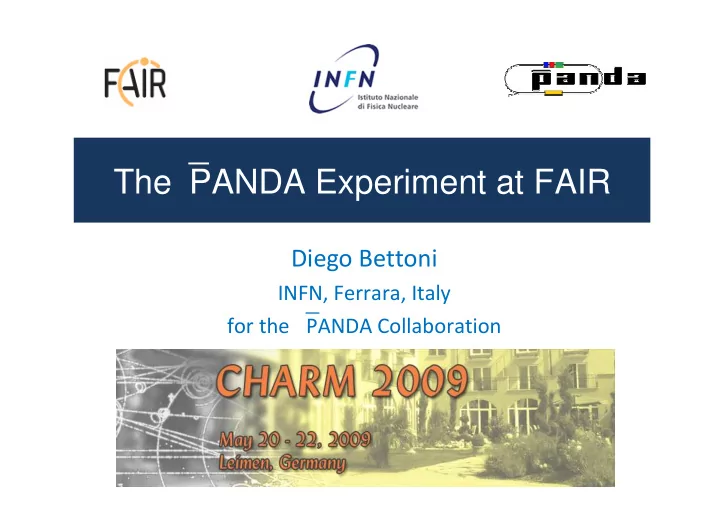

The PANDA Experiment at FAIR Diego Bettoni INFN, Ferrara, Italy for the PANDA Collaboration Charm 2009 Leimen, Germany, 22 May 2009
Outline • Introduction – The FAIR facility – Experimental Method The PANDA experiment • – Experimental Setup – The PANDA Physics Program • Physics Performance • Summary and Outlook
GSI Helmholtz Center and FAIR Unique Accelerator and Experimental Facilities for Forefront Research in the Areas: • Hadron Structure and Dynamics • Nuclear and Quark Matter • Physics and Chemistry of Super-heavy Elements • Nuclear Structure and Astrophysics • Atomic Physics, Plasma Physics, Materials Research, Radiobiology, ... • Accelerators and Detectors
The FAIR Complex
High-Energy Storage Ring • Production rate 2x10 7 /sec • P beam = 1.5 – 14.5 GeV/c _ = 5x10 10 p • N stored • Internal Target High resolution mode 5 (electron cooling) • δ p/p ~ 10 − − −5 − 5 5 • Lumin. = 10 31 cm − 2 s − − − −2 2 2 −1 − − 1 1 1 High luminosity mode • Lumin. = 2 x 10 32 cm − 2 s − − − −2 2 2 − −1 − 1 1 1 • δ p/p ~ 10 − 4 (stochastic cooling) − − −4 4 4 D. Bettoni PANDA at FAIR 5
pp Annihilation In pp collisions the coherent annihilation of the 3 quarks in the p with the 3 antiquarks in the p makes it possible to form directly states with all non-exotic quantum numbers. The measurement of masses and widths is very accurate because it depends only on the beam parameters, not on the experimental detector resolution, which determines only the sensitivity to a given final state. Diego Bettoni Charmonium 6
The PANDA Experiment Experimental Setup The PANDA Physics Program
PANDA Detector Detector Requirements • (Nearly) 4 π solid angle coverage (partial wave analysis) • High-rate capability (2 × 10 7 annihilations/s) • Good PID ( γ , e, µ, π , K, p) • Momentum resolution ( ≈ 1 %) s , Λ • Vertex reconstruction for D, K 0 • Efficient trigger • Modular design • Pointlike interaction region • Lepton identification • Excellent calorimetry • Energy resolution • Sensitivity to low-energy photons D. Bettoni PANDA at FAIR 8
������������� ���������������������� �������������� ���� ������������������������������� ��������� ��������� ������� �������� ���������������� ������� ����������� ������� !�������� !������� "������ "#������ "#����������� $%&%�� $%"%�%% ��������������������������������������������������� ��������������������������������������������������� ���������������� �������� �������� ����!�� ���������������� �������� �������� ����!�� ��" #�� ����!�� ����!�$�� %���&����'&��������'��������� ��" #�� ����!�� ����!�$�� %���&����'&��������'��������� �������������(������)���*���)��������)�����!��)+��� �������������(������)���*���)��������)�����!��)+��� �,�"-������"��.�%������/���!�����/0��)����������1��2����� �,�"-������"��.�%������/���!�����/0��)����������1��2����� 1����1��&��3���2��3���(����'#�3����!��3#'��3����!�� 1����1��&��3���2��3���(����'#�3����!��3#'��3����!�� �$�3-�������3-������������!�����������#���*�������(�� �$�3-�������3-������������!�����������#���*�������(�� �#��4������#�*����#������� 4�����������5'#�#���*����� �#��4������#�*����#������� 4�����������5'#�#���*����� #�#��+�6�#�����������/�5�+���(������+���(������$� #�#��+�6�#�����������/�5�+���(������+���(������$� ����������������������������#����������������������+1� ����������������������������#����������������������+1� $���������-��������$��������0���������+��+�7����!���$� $���������-��������$��������0���������+��+�7����!���$� 7����!��+3��7���� 7����!��+3��7���� ����������������������� D. Bettoni PANDA at FAIR 9
Recent Activities • Electromagnetic Calorimeter TDR written • Crystals funded • Dipole magnet and forward Č erenkov funded • Magnet TDR written • Tracking TDR in progress First version of PANDA • Physics Book completed. ArXiV:0903.3905.
PANDA Physics Program • QCD BOUND STATES – CHARMONIUM – GLUONIC EXCITATIONS – HEAVY-LIGHT SYSTEMS – STRANGE AND CHARMED BARYONS • NON PERTURBATIVE QCD DYNAMICS • HADRONS IN THE NUCLEAR MEDIUM • NUCLEON STRUCTURE – GENERALIZED DISTRIBUTION AMPLITUDES (GDA) – DRELL-YAN – ELECTROMAGNETIC FORM FACTORS • ELECTROWEAK PHYSICS D. Bettoni PANDA at FAIR 11
QCD Systems to be Studied in PANDA
QCD Bound States The study of QCD bound states is of fundamental importance for a better, quantitative understanding of QCD. Particle spectra can be computed within the framework of non-relativistic potential models, effective field theories and Lattice QCD. Precision measurements are needed to distinguish between the different approaches and identify the relevant degrees of freedom. • Charmonium Spectroscopy • Gluonic Excitations • Heavy-Light Systems • Strange and Charmed Baryons
Charmonium Spectroscopy Main issues • All 8 states below threshold observed, some (precision) measurements still missing: • h c (e.g. width) • η c (1S) • η c (2S) (small splitting from ψ (2S)) • The region above open charm threshold must be explored in great detail: • find missing D states • explain newly discovered states (c c or other) • confirm vector states seen in R
Charmonium at PANDA At 2 × 10 32 cm -2 s -1 accumulate 8 pb -1 /day (assuming 50 % overall • efficiency) ⇒ 10 4 ÷ 10 7 (c c) states/day. Total integrated luminosity 1.5 fb -1 /year (at 2 × 10 32 cm -2 s -1 , assuming • 6 months/year data taking). • Improvements with respect to Fermilab E760/E835 : – Up to ten times higher instantaneous luminosity. – Better beam momentum resolution ∆ p/p = 10 -5 (GSI) vs 2 × 10 -4 (FNAL) – Better detector (higher angular coverage, magnetic field, ability to detect hadronic decay modes) . Fine scans to measure masses to ≈ 100 KeV, widths to ≈ 10 %. • • Explore entire region below and above open charm threshold. • Decay channels •Precision measurement of known states – J/ ψ +X , J/ ψ → e + e - , J/ ψ → µ + µ − •Find missing states (e.g. D states) γγ – •Understand newly discovered states – hadrons – D D Get a complete picture of the dynamics of Get a complete picture of the dynamics of cc system. the the cc system.
Recommend
More recommend